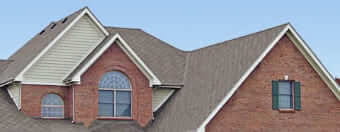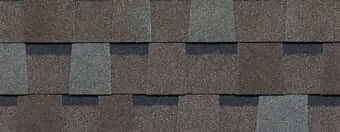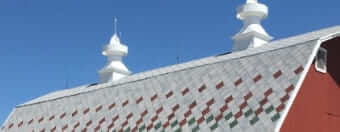from Sherriff Goslin Roofing
Choose your view:
A Complete Guide to Choosing the Best Window for Your Home
New windows impact more than just aesthetics—they affect how your home insulates, sounds, and functions day to day. The right window system can improve energy efficiency, reduce outside noise, and give your home the polished, updated feel you’re looking for. But with so many options available, how do you know which one is right for you?
If you’re replacing old windows or upgrading for better comfort, this guide walks you through the most common window types and materials to help you make an informed decision.
Compare the Most Popular Window Materials
Frame material plays a central role in how your windows perform over time. It affects insulation value, weather resistance, maintenance needs, and visual appeal. Some materials are designed for longevity with minimal upkeep. Others offer premium aesthetics but require more attention to preserve their finish.
Each option has distinct advantages depending on your priorities, such as energy efficiency, upfront cost, or architectural style. Below are the most common window frame types used in residential construction and what you can expect from each in terms of performance and long-term value.
Vinyl Windows
Vinyl windows are made from PVC and are among the most affordable, low-maintenance options available. They won’t peel, chip, or warp, and they resist moisture better than wood. Many vinyl windows also come with multi-chambered frames for better insulation.
Homeowners often choose vinyl for its value and efficiency. It works well in both new construction and replacement projects, and most styles can be customized with colors or faux wood finishes. While vinyl may lack the premium look of wood, it offers long-term performance with minimal upkeep.
Wood Windows
Wood windows offer classic beauty and natural insulation. They can be painted or stained to match your interior and are often chosen for historic homes or traditional aesthetics. When properly maintained, wood frames provide excellent thermal performance and a warm, timeless appearance.
However, wood does require regular upkeep to prevent rot, warping, or insect damage. It's best suited for homeowners willing to commit to occasional refinishing. If appearance and authenticity are priorities, wood remains one of the most attractive window materials available.
Fiberglass Windows
Fiberglass is known for its strength, stability, and resistance to weather changes. It can mimic the look of wood but lasts much longer and requires less maintenance. Fiberglass frames also expand and contract less than vinyl, reducing stress on seals and glass.
This material is often priced higher than vinyl, but the durability and energy efficiency can offset the upfront investment. Fiberglass windows are a solid choice for homeowners looking for longevity and a sleek, modern finish.
Aluminum Windows
Aluminum windows are strong, lightweight, and resistant to corrosion. They’re commonly used in commercial buildings but are sometimes selected for modern residential homes with narrow sightlines and large glass spans.
That said, aluminum conducts heat and cold more easily than other materials, which can make it less efficient in extreme climates like the Great Lakes region or the Florida panhandle. While it holds up well structurally, it may not offer the same level of insulation as vinyl or wood unless thermal breaks are included.
Consider Window Style, Energy Efficiency & Maintenance
The frame material isn’t the only factor to consider. Different window styles and glass options can also affect airflow, insulation, and aesthetics.
- Single-Hung vs. Double-Hung: Single-hung windows open from the bottom, while double-hung windows allow both sashes to move, making them easier to clean and more versatile for airflow.
- Casement Windows: Hinged on the side, casement windows crank open outward and offer excellent ventilation and sealing when closed.
- Sliding Windows: These open horizontally and work well in tight spaces where swinging sashes aren’t practical.
- Picture & Bay Windows: Designed for light and visual appeal, these fixed or extended styles are often used in living rooms or front-facing walls.
- Glass Options: Low-E coatings, double or triple panes, and gas-filled units can significantly boost energy savings and block UV rays.
When selecting your windows, consider how often you want to clean them, how much ventilation you need, and how much sun exposure each wall receives. A combination of styles and materials may give you the best results across your entire home.
Wondering Which Windows Are Right for Your Home? Talk to the Roofers at Sherriff Goslin Roofing
The best window system for your home depends on long-term efficiency, durability, and how well the windows complement your home’s layout and insulation. Choosing the wrong style or material can lead to heat loss, moisture intrusion, and higher utility bills over time. If you’re comparing vinyl, wood, or other window types, a professional consultation can help you avoid expensive mistakes.
Sherriff Goslin Roofing provides window installation and replacement services across Michigan, Indiana, Ohio, and Florida. Our team helps homeowners evaluate window condition, compare material options, and select systems that improve energy performance while enhancing curb appeal.
Schedule a Commercial Roof Inspection or Get an Estimate Today
Are you unsure which window style fits your space or whether it’s time to replace old, drafty units? We’re here to help. Sherriff Goslin Roofing offers in-home consultations to assess performance issues, recommend high-efficiency upgrades, and explain the pros and cons of each window type.
We’ll provide a clear estimate based on your home’s size, style, and budget. Financing options are available to keep your window replacement project on track. Contact us today to schedule your consultation.






